JavaScript is disabled for your browser. Some features of this site may not work without it.
Buscar en RiuNet
Listar
Mi cuenta
Estadísticas
Ayuda RiuNet
Admin. UPV
Efecto de la aplicación de giberelinas antes del periodo inductivo sobre la expresión del gen cift3 y la floración del naranjo (Citrus sinensis L.)
Mostrar el registro completo del ítem
Prades Aznar, G. (2022). Efecto de la aplicación de giberelinas antes del periodo inductivo sobre la expresión del gen cift3 y la floración del naranjo (Citrus sinensis L.). Universitat Politècnica de València. http://hdl.handle.net/10251/188511
Por favor, use este identificador para citar o enlazar este ítem: http://hdl.handle.net/10251/188511
Ficheros en el ítem
Metadatos del ítem
| Título: | Efecto de la aplicación de giberelinas antes del periodo inductivo sobre la expresión del gen cift3 y la floración del naranjo (Citrus sinensis L.) | |||
| Otro titulo: |
|
|||
| Autor: | Prades Aznar, Guillem | |||
| Director(es): | Marzal Blay, Andrés | |||
| Entidad UPV: |
|
|||
| Fecha acto/lectura: |
|
|||
| Resumen: |
[ES] La aplicación de giberelinas (GAs) para regular la floración es una técnica eficaz en la mayoría de especies de cítricos. La respuesta al tratamiento depende críticamente de la época de aplicación, en interacción con ...[+]
[EN] The use of gibberellins (GAs) to regulate flowering is an effective technique in most citrus species. The response to the treatment critically depends on the time of application, in interaction with the species. In ...[+]
|
|||
| Palabras clave: |
|
|||
| Derechos de uso: | Reserva de todos los derechos | |||
| Editorial: |
|
|||
| Titulación: |
|
|||
| Tipo: |
|
recommendations
Este ítem aparece en la(s) siguiente(s) colección(ones)
-
ETSIAMN - Trabajos académicos [3541]
Escuela Técnica Superior de Ingeniería Agronómica y del Medio Natural







